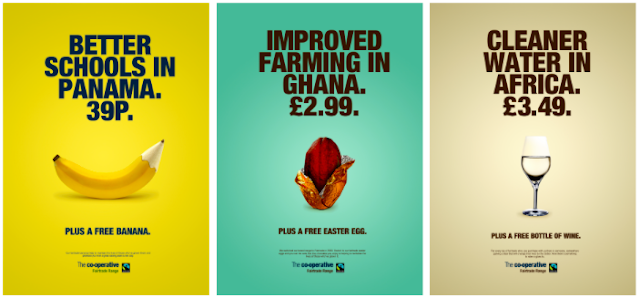Research- Marketing fair trade
The Fair trade foundation works to ensure that people at the very beginning of production lines that typically live in third world countries get a fair percentage of the profit made from a variety of products. These people do jobs such as working on cocoa, coffee and cotton plantations, mining and general manual labour in order to get a primary source that is turned into many different products. Companies used to pay these particular people an extremely small amount of money compared to the profit they were making, which is extremely unfair considering how essential the workers are to the final product. This is where Fair Trade came in and campaigned for better pay for the workers. This organisation subsequently worked with large companies to ensure they were helping the workers and investing in a better environment for them. The Fair Trade website states that;
"Twenty years ago, companies didn’t have traceability in their own supply chains, and they weren’t proactive about sustainability. But that’s changing – and we can take huge pride in driving that change. From our earliest days we have called on companies to acknowledge their social and environmental - not just their economic – impacts. We’ve challenged companies to be accountable for their actions and more and more companies are responding. That’s an extraordinary change and something that simply wouldn’t have happened without the Fairtrade campaign.
Many companies are now investing significant amounts of money in sustainability schemes designed to make life better for farmers. That’s a huge opportunity and one we will capitalise on through maximising the number of businesses that adhere to our standards, and are certified.
Increasingly, some companies also want to take direct control over how their investments are spent, which leads them to adopt their own development programmes, rather than third-party standards and certification.
Done right the benefits for a company investing in its own scheme are that it can set its own standards, choose its own means of verification, follow its own processes and, usually, save money. It can also potentially attract public funding as the government is increasingly committed to channelling aid money through the private sector.
But very importantly there are benefits for Fairtrade farmers and workers too if we partner with robust company-owned schemes. Not only does it take us a step closer to making our vision reality, we can make sure Fairtrade principles and theory of change impacts are embedded at the heart of a business. We can make sure farmers and workers are benefiting, and their needs are central – in line with our empowerment principle. That farmers have control through organisations over how their additional premium (or equivalent) income is spent. We can also ensure that there is transparency and we can hold businesses to account."
"Twenty years ago, companies didn’t have traceability in their own supply chains, and they weren’t proactive about sustainability. But that’s changing – and we can take huge pride in driving that change. From our earliest days we have called on companies to acknowledge their social and environmental - not just their economic – impacts. We’ve challenged companies to be accountable for their actions and more and more companies are responding. That’s an extraordinary change and something that simply wouldn’t have happened without the Fairtrade campaign.
Many companies are now investing significant amounts of money in sustainability schemes designed to make life better for farmers. That’s a huge opportunity and one we will capitalise on through maximising the number of businesses that adhere to our standards, and are certified.
Increasingly, some companies also want to take direct control over how their investments are spent, which leads them to adopt their own development programmes, rather than third-party standards and certification.
Done right the benefits for a company investing in its own scheme are that it can set its own standards, choose its own means of verification, follow its own processes and, usually, save money. It can also potentially attract public funding as the government is increasingly committed to channelling aid money through the private sector.
But very importantly there are benefits for Fairtrade farmers and workers too if we partner with robust company-owned schemes. Not only does it take us a step closer to making our vision reality, we can make sure Fairtrade principles and theory of change impacts are embedded at the heart of a business. We can make sure farmers and workers are benefiting, and their needs are central – in line with our empowerment principle. That farmers have control through organisations over how their additional premium (or equivalent) income is spent. We can also ensure that there is transparency and we can hold businesses to account."
In this set of posters the company (co-operative) are selling their products by primarily advertising the benefits that come from buying the product. They list the achievable outcomes as the product and price it, listing the actual product sold in the store as a free add-on. The images on the poster show both elements of the product and the fair trade outcome. The first image shows a Banana which is combined to a yellow pencil which enforces the message of the 'better schools'. The second image has a cocoa bean wrapped in gold foil representing an easter egg. This is promoting the 'improved farming' available from fair trade by buying the product. The final product is a wine glass with water in which represents the bottle of wine and the 'cleaner water'.
This second poster is selling the fair trade banana by incorporating the nike slogan 'Just do it' and portraying the banana as the 'tick'. The use of the slogan 'Just do eat' suggests urgency yet ease as the adjective 'just' conveys an easy action and implies that by just eating the product you can have an effect on fair trade.
The two posters above promote the fair trade ingredients used in Ben and Jerry's ice cream. The first poster shows a tropical cocoa plant inside a Ben and Jerry's ice cream tub. This is then paired with the slogan "It's what's inside that counts" which links together to create the Fair Trade message of the ingredients used. This first poster is advertising the fair trade cocoa and shows the farmer harvesting the beans inside the tub. Not only does the product sell because it had fair trade ingredients, the poster also promotes naturalness in the product by creating that particular scene inside the tub.
The second poster shows sacks of vanilla pods being transported onto a van along with the plants on either side. Similar to the previous poster they have used the natural setting to sell the product and uses the same slogan.
This poster is for Cadbury's and lists the simple steps you can take to benefit Fair Trade. The use of this step by step list creates a sense of ease as by doing such a small thing as eating chocolate the poster is insinuating that you will support Fair Trade.
These two posters are promoting beauty products from the Body Shop. The first poster uses three hair brushes to represent a forest as the shop is promoting the fact that they help sustain plantations and trade communities. The second poster also uses a type of brush which is portrayed to be a paint roller as the product is promoting building restoration in trade communities. Both of the posters clearly present the benefits to fair trade by buying the product and use the minimal layout of just the product and the information with nothing but one colour in the background.
The final two posters are promoting fair trade gold. The posters are not showing a lot of the product itself but instead shows the trade community in the third world countries doing the jobs which gets the product. The first poster shows the refining of the gold in a bowl and the second shows a solemn faced man in mining clothing. This contrast of the images used and the glamorous product that is actually being sold shows the reality of fair trade and the communities.











Comments
Post a Comment